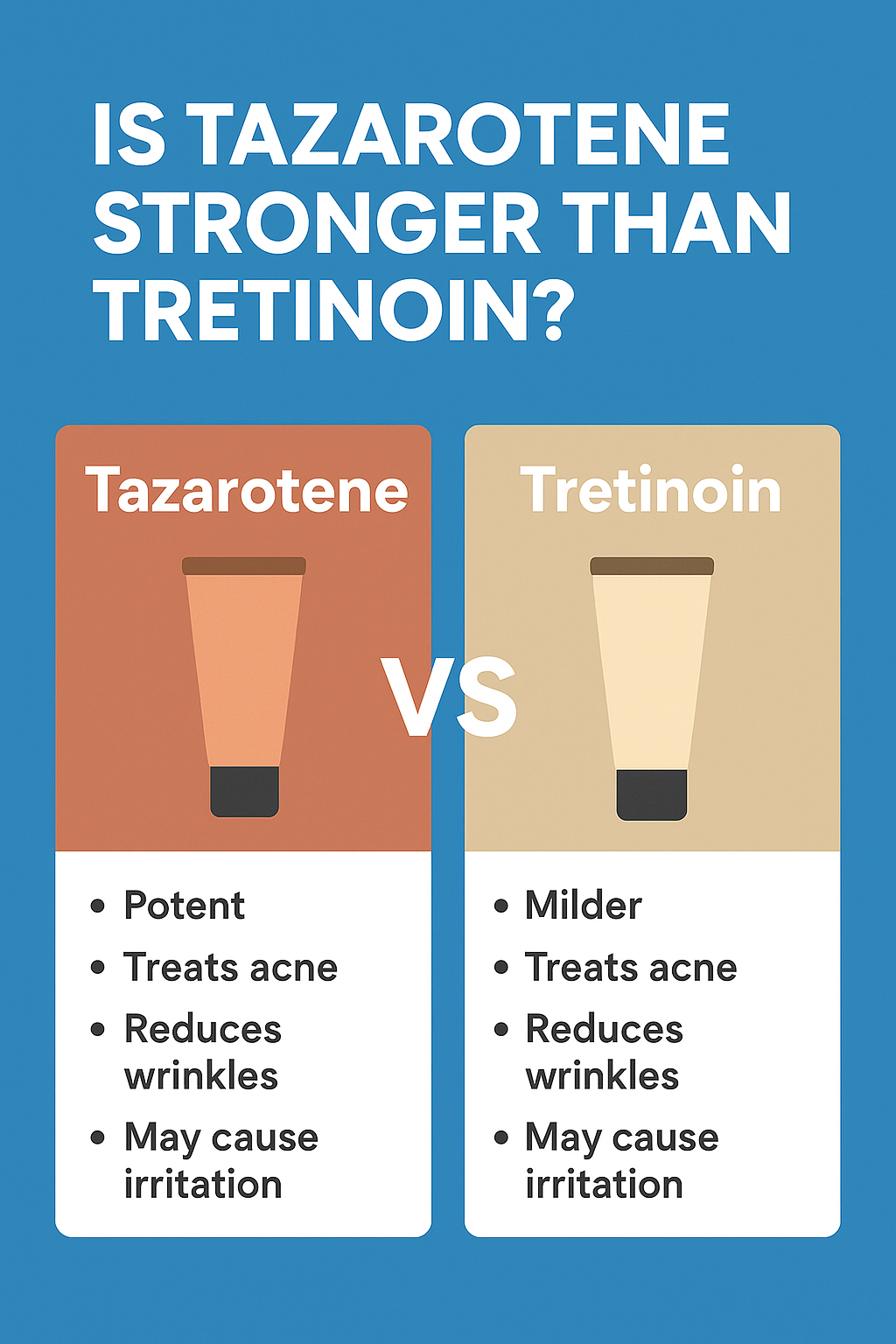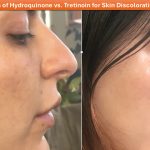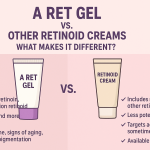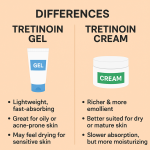Retinoids have revolutionised skincare, offering reliable solutions for acne, ageing, and overall skin health. Among the most well-known topical retinoids are tretinoin and tazarotene. Both are derivatives of vitamin A, but they differ in strength, tolerability, and how they work for different skin types. A common question that arises in dermatology and skincare circles is: Is tazarotene stronger than tretinoin? This comprehensive guide explores both treatments, their benefits, side effects, and which one may be best suited for your skin needs.
Understanding Retinoids
Retinoids are a group of vitamin A derivatives that regulate skin cell growth and turnover. By accelerating skin renewal, they unclog pores, stimulate collagen, and even out pigmentation. They are FDA-approved for acne, fine lines, wrinkles, and other dermatological conditions. While both tretinoin and tazarotene fall under this category, they are distinct in potency and application.
What is Tretinoin?
Tretinoin, also known as all-trans retinoic acid, is one of the first retinoids approved for topical use. It has been prescribed for decades and is considered the gold standard in dermatology.
Uses of Tretinoin:
- Treats mild to moderate acne
- Reduces fine lines and wrinkles
- Improves skin texture and pigmentation
- FDA-approved for photoaging
Formulations: Available in 0.025%, 0.05%, and 0.1% strengths, in cream, gel, and microsphere gel forms.
Pros:
- Well-researched with decades of data
- Suitable for long-term use
- Effective for a wide range of skin issues
Cons:
- Can cause redness, dryness, and peeling
- Results take 8–12 weeks
- Sun sensitivity is common
What is Tazarotene?
Tazarotene is a third-generation synthetic retinoid considered stronger and more potent than tretinoin. It is prescribed for acne, psoriasis, and photoaging.
Uses of Tazarotene:
- Effective for moderate-to-severe acne
- Reduces fine lines and pigmentation
- Manages psoriasis symptoms
- Approved for photoaging treatment
Formulations: Available in 0.05% and 0.1% strengths, in gel, cream, and foam formulations.
Pros:
- Stronger and more targeted activity
- Works faster than tretinoin in many cases
- Significant results in stubborn acne and photoaging
Cons:
- Higher irritation potential
- Not ideal for sensitive skin or beginners
- Generally more expensive
Tazarotene vs. Tretinoin: Potency and Effectiveness
The main difference between tazarotene and tretinoin is strength. Clinical studies have shown that tazarotene often provides more noticeable results in a shorter period compared to tretinoin.
- Acne: Both are effective, but tazarotene works faster and is better suited for resistant or severe acne. Tretinoin remains a reliable option for mild to moderate acne.
- Anti-Ageing: Tazarotene demonstrates greater improvement in fine lines and photoaging, but tretinoin still provides excellent long-term benefits.
- Pigmentation: Both even out skin tone, though tazarotene may act more aggressively.
Side Effects and Tolerability
Potency often comes with a trade-off—higher irritation.
- Tretinoin Side Effects: Redness, dryness, peeling, and temporary flare-ups when starting.
- Tazarotene Side Effects: Stronger irritation, dryness, stinging, and scaling. Less suitable for sensitive or dry skin types.
Dermatologists often recommend starting with tretinoin and progressing to tazarotene if stronger treatment is needed.
Head-to-Head Comparison
| Feature | Tretinoin | Tazarotene |
|---|---|---|
| Potency | Moderate | Higher |
| Acne | Best for mild-to-moderate | Best for moderate-to-severe |
| Anti-Aging | Effective | Stronger impact |
| Irritation | Moderate | High |
| Results Timeline | 8–12 weeks | 4–8 weeks |
| Cost | More affordable | More expensive |
Which One Should You Use?
The answer depends on your skin type, tolerance, and goals.
- Beginners: Start with tretinoin. It’s effective, widely studied, and more tolerable.
- Sensitive Skin: Tretinoin in a cream base is often recommended.
- Stubborn Acne: Tazarotene may be better due to its stronger action.
- Anti-Aging Goals: Both work, but tazarotene may give quicker, stronger results.
- Cost Considerations: Tretinoin is usually more budget-friendly.
How to Use Retinoids Safely
Regardless of which retinoid you choose, proper application is key:
- Start Slowly: Apply 2–3 nights a week before increasing frequency.
- Pea-Sized Amount: A small amount is sufficient for the whole face.
- Nighttime Use: Apply in the evening as retinoids degrade in sunlight.
- Moisturiser: Always pair with a good moisturiser to reduce irritation.
- Sunscreen: Essential for preventing sun sensitivity and damage.
- Be Patient: Results build up over weeks to months.
Expert Insights
Dermatologists emphasise that stronger isn’t always better. While tazarotene is technically stronger than tretinoin, the higher irritation can make it unsuitable for many people. For patients who tolerate tretinoin well but want more dramatic results, dermatologists may recommend switching to or alternating with tazarotene.
FAQs
Q1: Is tazarotene always better than tretinoin?
Not necessarily. Tazarotene is stronger but also harsher. Tretinoin remains an excellent choice for long-term use and sensitive skin.
Q2: Can I start directly with tazarotene?
It’s not usually recommended for beginners. Most dermatologists suggest starting with tretinoin first.
Q3: Which one works faster?
Tazarotene often shows visible results within 4–8 weeks, while tretinoin takes 8–12 weeks.
Q4: Do I need a prescription for both?
Yes, both are prescription-only medications in most countries.
Q5: Can I use them with other skincare products?
Yes, but avoid harsh exfoliants and always use sunscreen. Pairing with a gentle moisturiser helps manage dryness.
Conclusion
So, is tazarotene stronger than tretinoin? Yes, tazarotene is stronger and often works faster. However, that increased strength comes at the cost of higher irritation and expense. Tretinoin, on the other hand, is effective, affordable, and suitable for most skin types, especially for those new to retinoids.
Ultimately, the “better” choice depends on your skincare goals, tolerance, and whether you’re seeking a gentle long-term option or a stronger, more aggressive treatment. Consulting a dermatologist will help you decide which retinoid best suits your individual needs.
Final Takeaway: Both tretinoin and tazarotene are powerful retinoids with proven benefits. Tazarotene is stronger, but not always the better choice for everyone. If you’re considering adding one of these treatments to your skincare routine, work with your dermatologist to determine which is the safest and most effective option for your skin.





